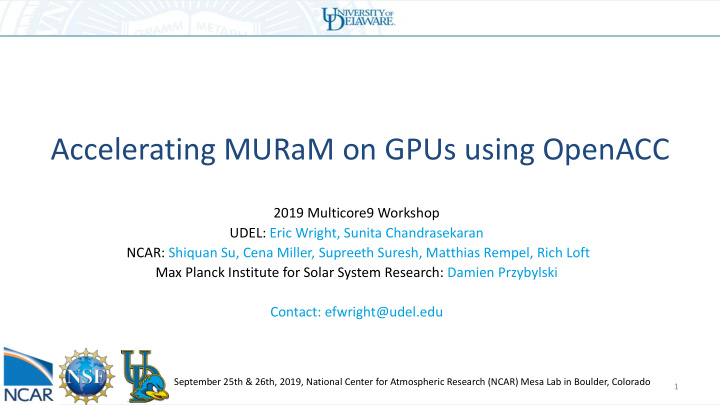



Accelerating MURaM on GPUs using OpenACC 2019 Multicore9 Workshop UDEL: Eric Wright, Sunita Chandrasekaran NCAR: Shiquan Su, Cena Miller, Supreeth Suresh, Matthias Rempel, Rich Loft Max Planck Institute for Solar System Research: Damien Przybylski Contact: efwright@udel.edu September 25th & 26th, 2019, National Center for Atmospheric Research (NCAR) Mesa Lab in Boulder, Colorado 1
Outline • MURaM Introduction • OpenACC Introduction • Development Tools • Development Roadblocks • Results 2
MURaM (Max Planck University of Chicago Radiative MHD) • The primary solar model used for simulations of the upper convection zone, photosphere and corona • Jointly developed and used by HAO, the Max Planck Institute for Solar System Research (MPS) and the Lockheed Martin Solar and Astrophysics Laboratory (LMSAL) MURaM simulation of solar granulation • The Daniel K. Inouye Solar Telescope (DKIST), a ~$300M NSF investment, is expected to advance the resolution of ground based observational solar physics by an order of magnitude • Requires at least 10-100x increase in computing power compared to current baseline 3
Physics of the MURaM Code • Science target – Realistic simulations of the coupled solar atmosphere – Detailed comparison with available observations through forward modeling of synthetic observables • Implemented Physics – Single fluid MHD – 3D radiative transfer, multi-band + scattering – Partial ionization equation of state – Heat conduction – Optically thin radiative loss – Ambipolar diffusion • Under development – Non-equilibrium ionization of hydrogen Comprehensive model of entire life cycle of a solar prominence (Cheung et al 2018) 4
Why OpenACC? 5
3 Ways to program CPU-GPU Architectures Applications OpenACC, Programming Libraries OpenMP Languages Directives (CUDA, OpenCL) “Drop - in” Incremental, Enhanced Maximum Acceleration Portability Flexibility
GPU Development and Tools 9
Development Cycle Broadwell Name Routine Summary: (v4) core: Analyze Analyze (sec) Update diffusion scheme - using TVD slope + flux TVD Diffusion 7.36812 limiting. Magnetohydrodyna Calculate right hand side of MHD equations. 6.26662 mics Calculate radiation field and determine heating Radiation Transport 5.55416 term (Qtot) required in MHD. Calculate primitive variables from conservative Equation of State 2.26398 variables. Interpolate the equation of state tables. Time Integration Performs one time integration. 1.47858 DivB Cleaner Clean any errors due to non-zero div(B). 0.279718 Boundary Update vertical boundary conditions. 0.0855162 Parallelize Conditions Optimize Grid Exchange Grid exchanges (only those in Solver) 0.0667914 Alfven Speed Limit Maximum Alfven Velocity 0.0394724 Limiter Synchronize Pick minimum of the radiation, MHD and diffusive 4.48E-05 timestep timesteps. 10
NVPROF: NVIDIA GPU Profiler • Profilers give detailed information/feedback about code execution • For this work, we used NVIDIA’s GPU enabled profiler too: NVPROF https://devblogs.nvidia.com/cuda-pro-tip-nvprof-your-handy-universal-gpu-profiler/ 11 https://devblogs.nvidia.com/cuda-pro-tip-nvprof-your-handy-universal-gpu-profiler/
CUPTI (CUDA Profiling Tools Interface) • Annotate code to give additional profiler feedback 12
CUDA Occupancy Calculator https://devblogs.nvidia.com/nvidia-turing-architecture-in-depth/ 13
PCAST (PGI Compiler Assisted Software Testing) • Automated testing features for PGI compiler • Able to do autocompare (sometimes) to make kernel debugging much easier • In our case, we used API calls to do some checking manually, but allowed for easy code testing after $ pgcc -ta=tesla:autocompare -o a.out example.c $ PGI_COMPARE=summary,compare,abs=1 ./a.out PCAST a1 comparison-label:0 Float idx: 0 FAIL ABS act: 8.40187728e-01 exp: 1.00000000e+00 tol: 1.00000001e-01 idx: 1 FAIL ABS act: 3.94382924e-01 exp: 1.00000000e+00 tol: 1.00000001e-01 idx: 2 FAIL ABS act: 7.83099234e-01 exp: 1.00000000e+00 tol: 1.00000001e-01 idx: 3 FAIL ABS act: 7.98440039e-01 exp: 1.00000000e+00 tol: 1.00000001e-01 14
Roadblocks 15
CUDA Occupancy Report 240x160x160 Dataset Kernel Name Theoretical Achieved Occupancy Occupancy MHD 25% 24.9% TVD 31% 31.2% CONS 25% 24.9% Source_Tcheck 25% 24.9% Radiation Transport Driver 100% 10.2% Interpol 56% 59.9% Flux 100% 79% 16
RTS Data Dependency Along Rays Data dependency is along a plane for each octant,angle combo. ● Depends on resolution ratio, not known until run-time. ● Number of rays per plane can vary. ● Vögler, Alexander, et al. "Simulations of magneto-convection in the solar photosphere-Equations, methods, and results of the MURaM code." Astronomy & Astrophysics 429.1 (2005): 335-351. 17
Solving RTS Data Dependency • We can deconstruct the 3D grid into a series of 2D slices • The direction of the slices is dependent on the X,Y,Z direction of the ray • Parallelize within the slice, but run the slices themselves serially in predetermined order 18
Profiler driven optimizations 19
Results 20
Experimental Setup • NCAR Casper system – 28 Supermicro nodes featuring Intel Skylake processors – 36 cores/node – 384GB memory/node – 4/8 NVIDIA V100 GPUs/node – PGI 19.4, CUDA 10 21
Results: CPU vs GPU Routine GPU time CPU time Speedup RTS 0.361 0.230 0.637 • Single NVIDIA V100 GPU MHD 0.108 0.160 1.48x TVD 0.056 0.066 1.17x • Dual Socket Intel Skylake CPU (36 core) EOS 0.031 0.071 2.29x • Measuring time taken for average timestep BND 0.004 0.007 1.75x with no file I/O INT 0.050 0.071 1.42x DST 0.163 0.031 0.19x • 192x128x128 sized dataset DIVB 0.076 0.029 0.38x TOTAL 0.853 0.701 0.82x 22
23
Strong Scaling 24
Weak Scaling 25
Summary • MURaM – Single fluid MHD – 3D radiative transfer, multi-band + scattering – Partial ionization equation of state – Heat conduction – Optically thin radiative loss – Ambipolar diffusion • Use OpenACC to port to GPU with directives – Incremental changes – Maintain single C++ source code • Tools: NVPROF, CUPTI, CUDA Occupancy Calculator, PGI PCAST Contact: efwright@udel.edu 26
Recommend
More recommend